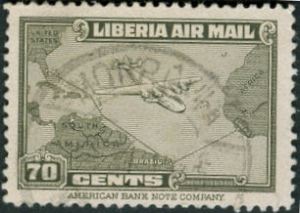
Kenya, Uganda, and Tanganyika, Scott 119, 1958, 32mm x 25mm
This issue commemorates the (European) discovery of Lakes Victoria and Tanganyika in 1858 by Sir Richard Francis Burton and Captain John Hanning Speke. The map shows the outlines of the “African Great Lakes” against the outline of the three colonies (Tanzania was formed by the union of Tanganyika and Zanzibar after independence), plus the northern end of Lake Nyasa to the south. A crowned head of Elizabeth II gazes on from the left. This stamp is an attractive example of a two-color engraved design, in green and blue.
Burton’s memoir The Lake Regions of Central Equatorial Africa (pdf) has many descriptions of nature and ethnography such as this:
The kikuki, assegai, or javelin is much used by the Warori and other fighting tribes, who enter action with a sheaf of those weapons. Nowhere, however, did the East African appear possessed of the dexterity described by travellers amongst the southern races. The assegai resembles the spear in all points, except that the head is often barbed, and it is more lightly timbered; the shaft rarely exceeds four feet in length, and tapers to the thinness of a man’s little finger. It is laid upon the palm of the right hand, and balanced with a vibratory motion till the point of equilibrium is found, where it is delivered with little exertion of the muscles beyond the run or spring, and as it leaves the hand it is directed by the forefinger and thumb.
I look through Speke’s memoir of the search for the source of the Nile as well, but did not find it quite as engaging somehow, probably because of the presumption of Western cultural superiority and the numerous accounts of gunning down the local wildlife. The explorer did not have a chance to go on any further explorations after the publishing of his two books, as he died of a self-inflicted gunshot wound in a hunting misadventure.
Currently, the nation of Kenya is troubled by civil unrest stemming from a disputed election. The other two countries are less in the news now.











